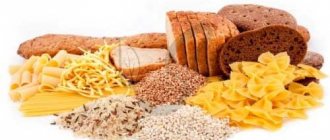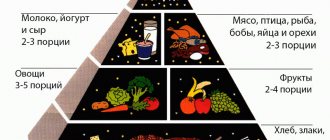- Why are fast and slow carbohydrates separated?
- What are fast carbohydrates?
- The role of fast carbohydrates in metabolism
- What are slow carbohydrates?
- Sources of fast and slow carbohydrates
| Carbohydrates are a group of organic compounds that are one of the nutrients the body needs, along with amino acids (proteins) and fatty acids (fats). Each of the carbohydrates is the basis of nutrition for the body; energy is primarily converted from them, used in the course of life. |
But carbohydrates are distinguished by a lot of criteria - by their nutritional value, by their structure and, what is especially interesting, by the time of processing into the simplest substances in the gastrointestinal tract. It is precisely according to the last criterion that they are divided into fast and slow carbohydrates . What is the difference between them and why delve into the differences?
Why are fast and slow carbohydrates separated?
As already mentioned, the division occurs according to the criterion of the rate of carbohydrate processing. The peculiarity of such a nutritional component for the human body as carbohydrates is that it is from them that the body primarily draws energy. During its daily activity, the body uses the energy it can get from carbohydrates. If it is not enough, then fats can be broken down, followed by proteins (but this is an extreme). If there is too much energy from carbohydrates, they are converted into a fat component and stored in reserve. At the same time, the level of cholesterol in the blood increases, and this, subject to regularity, does not have the best effect on the state of the cardiovascular system.
What does it mean to saturate the body with fast and slow carbohydrates ? What is the essence of obtaining that same energy? The key component of any carbohydrate is sugar. Meet:
- monosaccharides are simple sugars that cannot be decomposed into simpler ones, which means they are absorbed by the body immediately;
- disaccharides are slightly more complex sugars made of two molecules, which means that time is still spent on their breakdown;
- polysaccharides are the most complex compounds of sugar molecules, the body spends the most time breaking down them; they are absorbed with difficulty, and sometimes not at all, passing through the entire digestive tract and partially performing an excretory function (for example, fiber).
As soon as sugar enters the blood, the level of glucose in it rises, a person experiences a surge of strength, and the feeling of hunger and fatigue disappears as if by hand. But after a while, not a trace remains of the effect, since the hormone insulin “hurries” to normalize the level of glucose in the blood.
It turns out that fast carbohydrates, without requiring much time to break down polymer chains, provoke an immediate increase in glucose in the blood, and therefore a sharp release of insulin. In a healthy body, insulin neutralizes excessive amounts of glucose and transfers the incoming sugar to the fat layer. In a short time we begin to feel hungry again.
When a portion of slow carbohydrates enters the body, the sugar level increases gradually. There is no stress on the body. Insulin is released little by little, and the fat layer does not become a consequence of metabolism.
To distinguish between fast and slow carbohydrates, a special indicator was derived. It's called the glycemic index. The higher it is, the faster the product will break down. Foods with a low glycemic index are considered healthier for the body. Although in some, still very rare cases, the rapid supply of glucose to the blood may be relevant.
When consuming fast carbohydrates, the blood sugar level reaches its peak in 10-15 minutes, when consuming slow carbohydrates - in 30-40. The first “beacons” of hunger after fast carbohydrates will appear after 1-2 hours, and after slow carbohydrates - after 3-4 hours.
Why do athletes need carbohydrates?
Gaining muscle mass involves a rigorous and intense training program. At the same time, the energy expenditure in each workout is colossal. Energy is the calories that a person consumes, and the main source of calories is all groups of carbohydrates.
By increasing the amount of carbohydrates you consume, you will achieve an increase in the daily supply of glycogen in the muscles. It is necessary to turn this process of glycogen replenishment into a continuous one. It is worth remembering that consuming fast carbohydrates leads to their deposition on the stomach, which means that it is important to increase the consumption of long-term carbohydrates.
The more intense the training, the more mass you will gain, and the level of training load without proper carbohydrate consumption is impossible, which will lead to overwork and weight loss.
The ratio of carbohydrate intake to weight gain
By increasing the number of calories consumed per week by 2500, you will gain 0.5 kg in weight. That is, by adding just 400 calories per day, you can achieve significant results, but this condition only works in the presence of ultra-intense training.
It is important to monitor the appearance of fat deposits during weight gain. If this process has begun, it is better to reduce the number of calories you consume, since you simply are not producing them.
Also, in addition to food, you can increase your calorie intake by taking special carbohydrate supplements. Increasing the caloric content of food consumed does not necessarily mean eating more.
When calculating your carbohydrate intake with little or no weight gain, you should start by checking your protein and fat intake, is it enough?
Consumption of carbohydrates must be carried out in conjunction with a balanced diet rich in proteins and natural fats. Drinking carbohydrate drinks is a viable way to load your muscles with carbohydrates if you can't increase your food intake. However, sports nutrition in the form of carbohydrate drinks is not consumed during the day, but exclusively as part of the training process.
What are fast carbohydrates?
Fast or quickly digestible carbohydrates are those types of carbohydrates that are easily absorbed by the body in the shortest possible time. Usually they consist of monomolecules that cannot be decomposed into smaller components, which means that time and energy are not wasted on this. Fast carbohydrates include:
- glucose (grape sugar) - found in simple sugar and, of course, in sweets and jams; found in other foods, but in very small quantities;
- fructose (fruit sugar) - its processing does not require the release of insulin, but when it reaches the liver it is partially converted into glucose; the most fructose is in fruits and vegetables, honey;
- galactose (not found in its pure form), but the body receives it from milk and dairy products; from these products the body draws lactose and disaccharides, they are broken down into galactose and the same glucose; if glucose, in fact, is energy, then galactose is transported further to the liver, where it is again converted into glucose.
The role of fast carbohydrates in metabolism
Although at first glance it may seem that simple sugars and fast carbohydrates provoke stress for the body, a sharp jump in insulin and result in extra centimeters on the waist, but you also cannot do without them.
The simple structure of fast carbohydrates allows them to quickly enter the bloodstream. Hence their advantage - if you need urgent energy, foods with fast carbohydrates saturate you instantly. This is true, for example, after a morning workout. The body receives glucose in a short time, and its deficiency usually results in:
- fainting,
- fatigue,
- irritability,
- lack of performance.
At the same time, you need to remember that after a few hours there will be no trace of the surge of strength left, and therefore you need to prepare for a healthy meal that will provide energy for 3-5 hours or more.
Abuse of foods high in fast carbohydrates leads to extreme stress on the pancreas and liver. After all, it is she who produces insulin. Another vulnerable organ is the adrenal glands. But most often, due to an uncontrolled craving for sweets, starchy foods, or fast food, a person runs the risk of developing pancreatitis. Simple carbohydrates, which turn out to be fast, are most often empty calories. They are usually filling, so our body simply does not need so many calories, which means it will store them in reserve - on the organs and under the skin. The formation of fat is closely related to the process of insulin production. It is with his participation that fast carbohydrates turn into fat. The production of insulin in excess of the norm affects the breakdown of fat so that it contributes to the increase in adipose tissue.
Nutrition before and after training
Exception #1
constitutes a pre-workout meal: 1 hour before exercise, it is recommended to take carbohydrates with a high glycemic index (kefir, low-fat yogurt, jam, boiled potatoes or gainer) - at the rate of 1 gram of carbohydrates per 1 kg of body weight.

Exception #2:
post-workout nutrition. To replenish lost energy, ideally you need to take up to 100 g of carbohydrates with an average glycemic index within 30 minutes. This is extremely difficult to do due to lack of appetite, and this is where sweet drinks containing 10 grams of protein per 100 grams of carbohydrates come to our aid. The presence of protein in such drinks activates the enzyme glycogen synthetase, which accelerates the process of glycogen production and replenishment of its reserves in the muscles and liver. If instead we take whey isolate of free amino acids, then a mechanism called gluconeogenesis is activated - this is when glucose is synthesized from amino acids, which is deposited in glycogen stores. This pathway is not efficient and there is no need to force the body to engage in gluconeogenesis if free carbohydrates can be provided to replenish glycogen stores.
What are slow carbohydrates?
Slow or slowly digestible carbohydrates are disaccharides and, of course, polysaccharides. It takes time for the body to break down polymer chains. Some of these carbohydrates are absorbed gradually, and some leave the body in a slightly modified state.
Slow carbohydrates are the largest variety of polymer chains. These are disaccharides, but to a greater extent, of course, polysaccharides:
- maltose (malt sugar) is an intermediate product of the breakdown of starch and glycogen in the gastrointestinal tract;
- starch - is formed and contained in the chloroplasts of the green parts of the plant in the form of small grains, from where, through hydrolysis processes, it turns into water-soluble sugars, which are already contained in other parts of the plant (seeds, roots, tubers); the breakdown of starch in the human body begins in the mouth, where it turns into maltose, and glucose is produced from it;
- glycogen is the main form of glucose storage in animal cells, deposited in granules in the cytoplasm of many cells (liver, muscles), while the body itself resynthesizes glycogen as an energy material to power working muscles, organs and systems;
- pectins are soluble, rarely absorbed by the body substances formed by galacturonic acid residues; they can be found in all higher plants, especially fruits, and in some algae; in the human body they function as an enterosorbent;
- fiber - if pectins are partially absorbed by the body, then fiber does not undergo this at all, but its chemical structure is very close to polysaccharides; Grain products are characterized by a high fiber content; There are more delicate types of fiber, which are somewhat absorbed by the body under the influence of moisture, but any fiber remains, first of all, an enterosorbent that removes cholesterol from the body.

The role of polysaccharides

Our body needs useful multifunctional compounds - without them it will not be able to function properly:
- They serve as the main source of energy - if you refuse carbohydrate foods, you will feel tired, lethargic, and lack of strength.
- Directly associated with proteins - if the necessary substances do not enter the blood, the body cannot use the protein obtained from food for further work. All he can do is take what has already become building material for muscles. Gluconeogenesis (that’s what this process is called) leads to a decrease in the volume of muscle tissue, and this is fraught with a slowdown in metabolism - a change that is unacceptable when losing weight.
- They normalize the state of the nervous system - it has been proven that a low-carbohydrate diet is dangerous for our brain - it helps to reduce mental acuity.
- Helps avoid hypoglycemia - or a condition when blood sugar levels drop to a critical level. Symptoms: weakness, pallor, dizziness, fainting, hunger.











